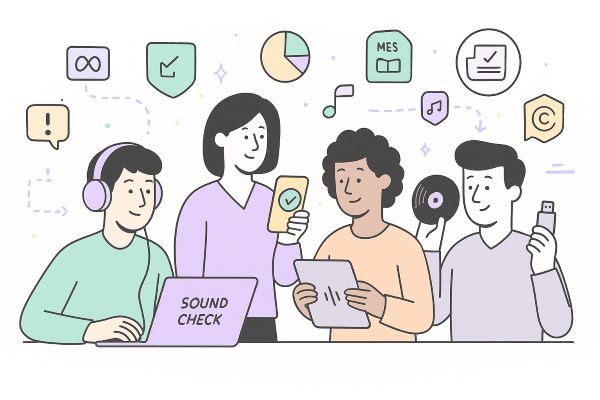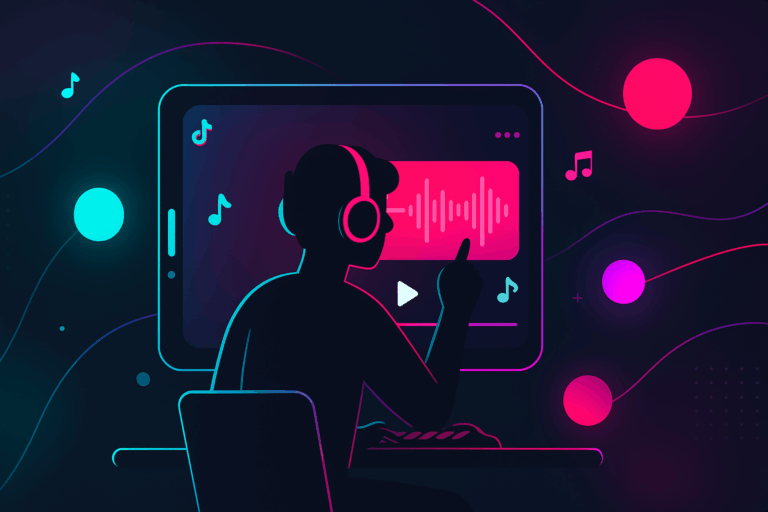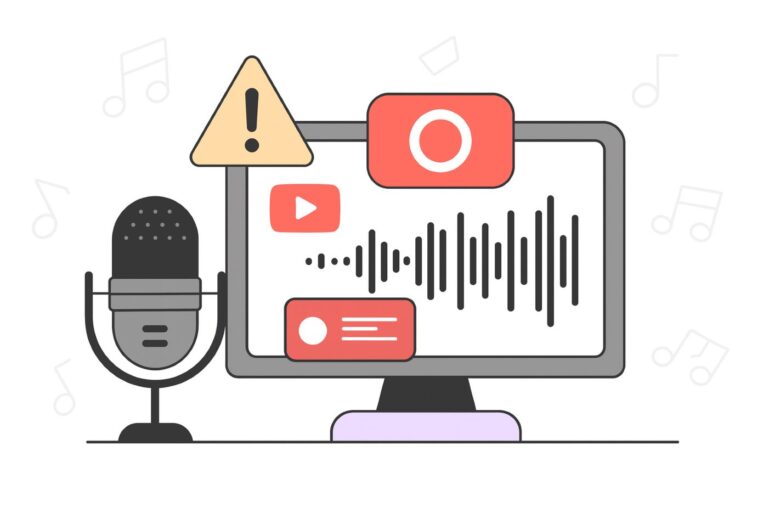TikTok Commercial Sounds vs TikTok Sounds Library
Audiodrome is a royalty-free music platform designed specifically for content creators who need affordable, high-quality background music for videos, podcasts, social media, and commercial projects. Unlike subscription-only services, Audiodrome offers both free tracks and simple one-time licensing with full commercial rights, including DMCA-safe use on YouTube, Instagram, and TikTok. All music is original, professionally produced, and PRO-free, ensuring zero copyright claims. It’s ideal for YouTubers, freelancers, marketers, and anyone looking for budget-friendly audio that’s safe to monetize.
TikTok punishes guesswork with its music rules. If your team still treats Commercial Sounds and trending audio as the same thing, this guide will show exactly where the line sits and how to stop gambling with soundtracks for campaigns.
The Difference Between TikTok Commercial Sounds and the Regular Sounds Library
“Commercial Sounds” and the regular Sounds Library represent two completely different licensing worlds. One environment speaks the language of brands, briefs, and approvals, while the other belongs to everyday users chasing trends for personal entertainment.
TikTok’s Commercial Music Library gathers pre-cleared tracks that businesses and organizations can use for campaigns on TikTok, both organic and paid, within published rules. TikTok’s Business Help Center and Creative Center outline this framework so marketers stop guessing and start working with documented, platform-specific clearance.

The standard Sounds Library throws up hits, trending audio, memes, and user-generated clips that feel perfect for reach and culture. TikTok structures those rights around personal or entertainment-style use, so brands should not treat them as a safe default soundtrack for promotions or sponsored content.

When you switch into a Business or Organization account, the catalog changes, and most mainstream songs disappear because TikTok limits those tracks to personal entertainment use. Instead, the interface steers you into Commercial Sounds, where TikTok signals options built for commercial storytelling on the platform.

If a track appears under Commercial Sounds or inside the CML, TikTok effectively says you may use it for commercial content on TikTok within the stated terms. That clearance stops at TikTok, so you treat Reels, Shorts, YouTube, podcasts, and TV as separate licensing questions.

If a track only lives in the regular Sounds Library, act as if it does not belong in your brand ecosystem unless you hold written rights from the relevant owners. That mindset protects campaigns, clients, and budgets when trends tempt your team into risky shortcuts.
What People Think “Commercial Sounds” Means vs What TikTok Actually Means
Many creators, agencies, and comment sections throw around “commercial sounds” as a comfort phrase that covers anything popular that seems safe to copy. In their heads, it includes trending audios, edits, “no copyright” uploads, and random royalty-free tracks that other brands appear to use.
TikTok uses “Commercial Music Library” and “Commercial Sounds” for a set of tracks it marks as pre-cleared for commercial use on TikTok for eligible accounts. These tracks live in a system in TikTok’s Business Help Center and Creative Center that explains conditions and placements.

If TikTok has not labeled the track, your agreement never mentions it and you cannot show written proof, you should not present that audio as “commercial” in any review. Treat doubt as a signal to switch sounds, backed by music you can document in one clear sentence.
How TikTok Commercial Sounds Work Inside the App
On a personal or creator account, the Sounds Library looks almost endless, filled with chart songs, trends, memes and inside jokes that fuel TikTok culture. The experience invites playful, entertainment-focused posting where your clips feel personal, not like structured brand campaigns.
That freedom works when you share genuine lifestyle moments, experiments or storytelling that do not sell or promote anything concrete. The moment a post starts to push a product, client, or offer, you step outside the comfort of those consumer licenses and need provable rights instead of vibes.
On a Business or Organization account, the sound picker changes and most mainstream songs disappear, which often feels like a loss until you see the logic behind it. TikTok directs you into Commercial Sounds and the CML, where tracks carry specific approval for commercial use on TikTok.

TikTok treats every upload from these accounts as part of a commercial presence, so the platform expects you to choose from this pre-cleared pool or from music you have licensed yourself. Once teams accept that frame, they stop hunting loopholes and start building habits they can defend in writing.
When TikTok Treats Your Sound Choice as Commercial Use
If your video promotes a brand, product or service, you should use tracks from the Commercial Music Library, because music outside it does not come with commercial rights. In practice, your content counts as commercial when it:
- Promotes your brand, product, service, app, event, course, or client.
- Includes #ad, #sponsored, paid partnership tags, discount codes, affiliate links, or similar.
- Is being run, boosted, or repurposed as ads, Spark Ads, or allowlisted/allowlisted posts.
Once you see that line, it becomes clear that Business and Organization accounts count as commercial by default, so TikTok expects them to rely on the Commercial Music Library or music they have licensed directly. Creators cross into the same category the moment they promote brands, sign UGC deals, use sponsorship tags, or approve Spark and Promote campaigns on their clips.
Safe vs Unsafe Sound Types For “TikTok Commercial Sounds” Searches
When teams argue about “safe sounds” on TikTok, what they really need is a short list of sound types they can trust and a short list they should treat as off limits.
Safe Buckets
Commercial Sounds and the Commercial Music Library sit at the center of TikTok’s official guidance, since TikTok presents these tracks as pre-cleared for commercial use on TikTok for eligible accounts and supported placements. They are your platform’s native option for ads and branded content, as long as you treat that clearance as TikTok only.

Original tracks you fully control give you even more leverage, as long as you can show who owns the master and who owns the publishing and confirm they approved TikTok and advertising use in writing. When that paper trail exists inside your folder, your edits travel cleanly across campaigns and formats.

Third-party royalty-free or licensed libraries can be a safe backbone when the contract speaks clearly about TikTok, commercial use, client work, paid ads, Spark, or allowlisting, territories, and duration. If any of those pieces stay vague or missing, treat the track as a question mark until your provider closes the gap.






Risky Buckets
General trending sounds that sit in the regular Sounds Library and show up in brand, sponsored, or client content create instant risk, because TikTok’s own policy says licenses for music outside the CML do not cover commercial use. When a video sells, recruits, or features a partner, those catchy hits stop being harmless background noise.

CML tracks that you export to Reels, Shorts, YouTube, TV or paid social outside TikTok move into another danger zone, because TikTok defines the Commercial Music Library as pre-cleared for use on TikTok only and does not promise rights on other platforms. Unless a separate agreement extends that clearance, you should treat cross-posting as unlicensed and pick music that comes with written multi-platform rights.
How To Choose TikTok Commercial Sounds For Business Accounts (Step-by-Step)
Start by asking if this piece of content behaves like advertising, not entertainment. If it promotes a brand, product, service, client, event, or code, or runs as Spark, Promote, or paid media, TikTok’s own guidance pushes you into the Commercial Music Library.
Once you confirm the post is commercial, look at who presses publish, because that choice decides your lane. Business and Organization accounts must stick to CML or properly licensed tracks, and creators who work with brands should follow the same standard even if TikTok still shows them popular songs.
With that foundation in place, open Commercial Sounds or the CML in the TikTok app or Creative Center so you work inside TikTok’s approved environment. Use the filters for region, usable placements, and themes to match the sound to how and where your campaign will run.
When you shortlist options, pick your track like you pick a spokesperson, with intention and proof in mind. Only use sounds that appear as Commercial Sounds for your account type and match the regions and placements your media plan actually covers.
As your team moves faster, protect them with simple documentation habits that live in one shared sheet. For every track, record the title, CML or sound link, account, campaign name, region, placement, and date, so anyone can answer licensing questions in seconds instead of hunting DMs.
If the campaign needs to breathe beyond TikTok, treat that as a different decision instead of stretching CML rules. Choose music from a trusted library or your own catalog that states in writing that it covers TikTok, Meta, YouTube, paid ads, allowlisting, and client deliverables, then build all edits around that anchor.
Why Brands Lose Popular Songs When They Switch To a Business Account
TikTok’s own account guidance explains that Business and Organization accounts lose access to the general music library because those tracks sit under licenses for personal entertainment use, not brand campaigns. In return, TikTok gives these accounts the Commercial Music Library as the approved source for commercial content on TikTok.
If you still see brands using trending hits:
- They might be posting from creator/personal accounts in a grey area.
- They might have direct licensing deals.
- They might be ignoring the rules and hoping not to be flagged.
Your best move is simple: be the account that proves clearance in one email instead of arguing that “everyone else does it.”
TikTok Commercial Sounds For Ads, Spark, and UGC
Ads are where loose assumptions fall apart, so treat every soundtrack like evidence. For in-feed ads and Promote campaigns, music must be cleared for commercial use, and TikTok’s own guidance directs brands to the Commercial Music Library, since music outside it does not come with commercial rights for promotional content.

The same logic applies when you run Spark Ads or allowlist UGC, which means you build music rules into creator briefs instead of fixing problems later. Ask creators to use CML tracks or your licensed catalog from the first draft, and avoid regular library hits unless you hold written, track-specific rights, otherwise, that viral post cannot safely become paid media.
When TikTok prompts you with Music Usage Confirmation and asks you to confirm rights, it is a handover of responsibility. By accepting, you state that you obtained all necessary licenses outside CML, a claim that third-party licensing guides also highlight, so your team should only click yes when the paperwork exists.
How To Build a Clean, Defensible TikTok Sound Policy
A clean TikTok sound policy starts with one belief: music choices are records you might need to defend. When you put that in writing for your team, you turn guesswork into a simple checklist that survives audits, staff changes, and nervous clients.
Use Commercial Sounds and the Commercial Music Library whenever you publish brand content, client work, paid campaigns, or anything that could influence sales and reputation on TikTok. Treat that environment as your default for in-feed ads, Spark activity, product pushes and performance reports that land in a boardroom.
Bring in your own licensed or royalty-free catalog when the story needs to travel beyond TikTok and you want one soundtrack for every cut. Choose catalogs that spell out rights for platforms, formats, and clients in clear language so your creative team never needs to reverse engineer legality after a launch.

Make documentation part of the creative process, not an extra chore at the end of the month. For every approved track, save the title, link, license source, date, campaign, and platforms in one shared sheet so anyone on the team can prove clearance in a single reply.

Run each planned post through a quick decision flow that feels natural: decide whether the clip sells or promotes anything, confirm which account publishes it, identify whether the soundtrack belongs to CML, your licensed catalog or the general Sounds Library, then confirm which platforms and placements the final edit will touch.
Use the TikTok Music Licensing Tool as the practical front door into this policy so people do not rely on memory alone. The tool translates these rules into tailored recommendations, turns messy inputs into clear next steps, and quietly builds a defensible trail behind every sound you approve.
Sourcing legal music for this TikTok
Answer a few items and get a clear recommendation with simple next steps.
Reminder: TikTok designs the Commercial Music Library for content and ads on TikTok. TikTok does not explicitly allow CML tracks outside TikTok. Use royalty free with multi platform rights when you plan to repost.
Your recommendation
Based on your inputs
Embed This Tool on Your Website

FAQs
Do I need a public TikTok account to use an artist’s music in my videos?

You can use eligible sounds from TikTok’s own library on both public and private accounts, subject to their normal rules. A public account is not what grants rights, the sound’s licensing and your use case do, so brand or promo content still needs Commercial Music Library or separate licenses.
Can I reuse TikTok or CapCut videos with music on Facebook, especially for bonuses or monetization?

Music that TikTok licenses for its own platform does not automatically carry over to Facebook’s programs, and quiet background use still counts as use. For monetized or bonus-eligible content, follow Meta’s Music Guidelines and use Meta Sound Collection or properly licensed audio instead of TikTok sounds.
Why are my posts or monetization checks declined for music when others use the same songs without issues?

Platforms enforce rights unevenly and factor in territory, specific track rights, account history, and whether content looks commercial. Someone else getting through does not make a track safe, so treat rejections as a signal to swap to platform-approved or licensed music you can document.
If I repost a TikTok to Facebook or Instagram, should I remove the original TikTok sound and use in-app audio?

Yes, that is the safe approach, because TikTok’s sound licensing lives inside TikTok and Meta’s tools rely on separate agreements. Re-upload the edit without the original TikTok music and add audio from Meta’s own libraries or from a license that clearly covers all platforms.
As a brand, can we use trending hits on TikTok for campaigns and ads?

For brands, especially Business and Organization accounts, TikTok’s own rules direct you to the Commercial Music Library for commercial content, not the general trending library. Using unlicensed hits in branded posts or ads can breach both TikTok’s terms and underlying music rights unless you secure direct sync and master licenses.
How should editors handle music when cutting TikToks for clients or commercial projects?

Treat every paid or client piece as commercial and build edits with CML tracks, a licensed catalog or custom music that lists TikTok explicitly. Avoid dropping in random trending sounds, because “everyone uses it” does not equal permission and leaves the client carrying the risk.
Can I rely on fair use or TikTok’s license to move music from TikTok videos to other platforms?

No, fair use is narrow and unpredictable, and TikTok’s licenses cover its own service, not reuse on YouTube, Facebook or elsewhere. When you export content, you either need music that came from a multi-platform license or you must replace the audio with something you can prove.
Soundtracks That Survive Scrutiny
Treat TikTok Commercial Sounds as one lane in a bigger licensing system. When you combine CML, proven libraries, and a simple decision flow, every soundtrack in your campaigns can survive questions from platforms, clients, and lawyers without panic.

Audiodrome was created by professionals with deep roots in video marketing, product launches, and music production. After years of dealing with confusing licenses, inconsistent music quality, and copyright issues, we set out to build a platform that creators could actually trust.
Every piece of content we publish is based on real-world experience, industry insights, and a commitment to helping creators make smart, confident decisions about music licensing.














